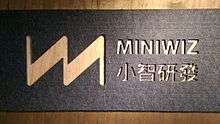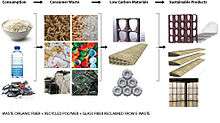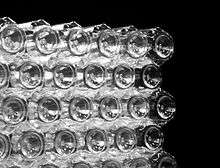Miniwiz
 Miniwiz office entrance | |
| Founded | 2005 |
|---|---|
| Headquarters | Taipei, Taiwan |
Key people | Arthur Huang |
| Services | Upcycling solutions |
Number of employees | 40 |
| Website |
www |
Miniwiz (or MINIWIZ, LTD., Chinese: 小智研發股份有限公司) is an Internationally operating and privately owned company dedicated to upcycling consumer trash and industrial waste. It creates low carbon footprint materials, semi-finished goods and building modules suitable for uses ranging from construction to consumer products. The company was established in 2005.
Description
Miniwiz was created in March 2005 by architect and structural engineer Arthur Huang and Jarvis Liu, an architect engineer. The company was registered and located in Taipei, Taiwan. In 2007, Miniwiz developed the Hymini, a portable wind, solar and handcrank power generator made from recycled ABS. Soon Miniwiz became active first as a green building material consultant, then as a building material manufacturer.
The World Economic Forum recognised Miniwiz as a Technology Pioneer in 2015[1] in the category “Energy / Environment / Infrastructure”, highlighting the positive impact that the company’s activity has on the world’s environment and economic growth. At the same time, Miniwiz received much media attention and many awards for its innovations in the recycling and building-material sector.
Employees
Miniwiz employs 40 engineers and administration staff. A team of chemical, mechanical, structural and industrial engineers is leading the company's R&D activities, other employees work in areas of architecture, industrial design and engineering.
Governance and operation
The company’s leadership team comprises:
- Arthur Huang, founder and Chief Executive Officer
- Jarvis Liu, co-founder and Chief Technical Officer
- Tina Chang, partner
- Johann Boedecker, partner
Products
Products

Miniwiz develops and sells materials 100% recycled from waste, but also re-engineers them into various applications. It recycles trash - including electronic, food, agricultural, packaging and automotive waste - into products like cellphone cases, sunglasses, interior applications, and construction materials.[2]
Materials
Miniwiz claims that most of post-consumer, agricultural and industrial waste can be recycled into materials that, if enhanced, can be reused to substitute any virgin material. Avoiding the usage of toxic and environment polluting chemical agents, Miniwiz reworks the composition of its recycled materials. Miniwiz developed a set of materials 100% made from trash that combines polymers with Nano-Silica extracted from organic elements of agriculture waste as well as other non-toxic chemical and mechanical reinforcements. Polymers developed by Miniwiz all enter in the category of thermoplastics, ensuring a reduced carbon footprint during the phase of transformation into products and possible re-recycling after usage.
Building modules
Miniwiz develops modular elements for construction and interior architecture purposes. Made of Miniwiz materials, modules are engineered around the general ideas of:
- Interlocking functions, to avoid the need of any chemical bonding agents
- Easy mounting and dissembling
- Minimum amount of material used, 100% recycled and re-recyclable.
- Cost Saving

Building modules developed by Miniwiz include:
- Polli-Brick, a building module made from 100% recycled PET (Polyethylene terephthalate), that is translucent, naturally insulated, and durable. Polli-Brick won The Earth Awards and placed Miniwiz as a finalist in The Wall Street Journal’s Asian Innovation Awards.
- Eco-Morph, a modular shelving system with a wooden finish, made from three green materials, recycled aluminum,PC from recycled post-consumer CDs and DVDs and FSC certified Mahogany or Teak.
- Polli-Ber wall system, contrary to conventional bricks, Polli-Ber bricks does not require any mortar, the bricks connect to one-another by means of either a connecting pin, or by clicking the bricks together with their sides.[3]
- Ricefold, can be folded into a 3D ceiling panel and installed in standard ceiling T-bars. Consisting of recycled PC (Polycarbonate) from water containers and compact discs mixed with SiO2 extracted from agro-waste rice husk (used as a bonding agent and performance enhancer).
End-user products
Miniwiz designed various pieces of furniture and consumer goods, made of recycled materials. Some of them include Hymini, a wind, solar and hand-crank charger that can be fixed on a bike or one’s arm to recharge electronic items’ batteries using natural sources of power;[4] Review, sunglasses made from recycled post-consumer CDs and DVDs;[5] as well as shelving systems and wine cases made from recycled materials.
Major Projects
EcoARK

EcoARK was the main exhibition hall for the Taipei International Flora Exposition. Commissioned by Far Eastern Group, the nine-story tall pavilion is made of 1.5 million[6] Polli-Bricks, which saved 300 tons of plastic from ending up in landfills.[7] The transparent nature of the Polli-Bricks allows the pavilion to be naturally lit, whilst the air pockets in the help insulate the structure.[8] Like a giant LEGO building, the use of Polli-Bricks allows the structure to be disassembled and assembled elsewhere.[9] Polli-Brick’s low weight and strong bond of the units make EcoARK both earthquake- and hurricane-resistant.[10] It is featured in an hour-long special by National Geographic Channel’s Megastructures:EcoARK.[11]
Recycling Plant
Miniwiz worked with SDTI, one of Taiwan's leader in electronic waste recycling, to rethink the recycling process with a more sustainable approach and limit potential health issues and environmental impacts. Miniwiz designed and built SDTI's new factory using the IT waste produced by existing SDTI recycling plants.[12] It is featured in National Geographic special "Megastructures: Urban Mine".[13]
NikeLab
Constructed from blocks of a recycled polymer composite made by combining Nike Grind, a premium grade raw material derived from recycled athletic shoes and materials left over from the manufacture of Nike product, with non-toxic, odorless eco-polyurethane. NikeLab stores can be found in six cities around the world: New York, London, Paris, Milan, Shanghai and Hong Kong.[14][15]
Le Blé d'Or
Le Blé d'Or restaurant- Xinzhuang store is located in New Taipei City, Taiwan. Directly related to the theme of the restaurant, the main material developed (entrance walls, ceiling, chairs) is a bio composite of recycled PP injected with hop and wheat husks issued from wastes of beer brewing. In the entrance, the Polli-Ber Bricks wall system set the tone. The semi-opaque leveled surface, with its gold-brownish shade, creates a casual yet sophisticated atmosphere. As for hops chair, its translucent body finish adds an extra layer to the depth of the chair’s aesthetic scope. No glue is incorporated in this design, ensuring maximum recyclability after its life cycle.
EcoFighter
In May 2015 Miniwiz announced the Ecofighter project, which would transform a "Veri EZ” Experimental Aircraft by replacing its original elements with flexible but resistant recycled materials. This included a material called SRPX - self reinforced polymer matrix. After the Ecofighter has undergone the re-engineering process it was planned to take flight later in 2016, documenting environmental damage and environmental progress across the globe.[16]
Anything Butts
In April 2016 Miniwiz and Philip Morris International (PMI) launched a collaboration during Milan Design Week. A new material made with recycled filters of iQos heatsticks was applied to architect Cesare Leonard’s 1960s furniture designs. The collaboration was presented in Palazzo Clerici courtyard among an installation of iQos tetrapods, an air-purifying, illuminated, self structured retail fixture system, designed to tell the story of iQos. Tetrapods are made with 100% post consumer recycled materials and air purifying amorphous bamboo charcoal and can be entirely re-recycled. A board of Plyfix foam was made with recycled iQos filters or regular cigarette filters.[17]
Awards
- Earth Award, Winner (Industrial Product), Financial Times, London, United Kingdom (2010)[18]
- Finalist for Wall Street Journal Innovation Award, Hong Kong (2011)[19]
- Make a Difference (MAD) Award, Ministry of Cultural Affair, Hong Kong, China (2012)[20]
- IDEA GOLD Award, Chicago, USA (2013)[21]
- Technology Pioneer, category “Energy / Environment / Infrastructure”, World Economic Forum (2015)
References
- ↑ "Miniwiz 1st local firm to win WEF pioneer award". www.ChinaPost.com.tw. Retrieved 2015-10-15.
- ↑ Nunns, Cain (2013-11-29). "Short on Space, Taiwan Embraces a Boom in Recycling". The New York Times. ISSN 0362-4331. Retrieved 2015-10-16.
- ↑ "BDNY 2015". from the source. Retrieved 2015-12-10.
- ↑ "HYMINI Tiny Portable Wind-powered Gadget Charger". inhabitat.com. Retrieved 2015-10-15.
- ↑ "Sunglasses Made from Recycled CDs and DVDs". Core77. Retrieved 2015-10-15.
- ↑ Brit Liggett (April 14, 2010). "EcoARK Pavilion made from 1.5 Million Plastic Bottles". Inhabit. Inhabitat.com. Retrieved 2 Sep 2012.
- ↑ Paul Mozur (6 July 2011). "Miniwiz Builds Its Green Presence, Brick by Brick". The Wall Street Journal. Retrieved 2012-01-12.
- ↑ Annie Huang (May 17, 2010). "Taiwan builds plastic bottle structure". Bloomberg Businessweek. Retrieved 2012-01-12.
- ↑ "EcoARK built with 1.5 million plastic bottles". The China Post. April 13, 2010. Retrieved 2 Sep 2012.
- ↑ "Polli-Brick". DETAIL Magazine (in German). December 2010.
- ↑ "MEGASTRUCTURES: ECOARK". National Geographic. NGC Europe Limited. Retrieved 2 Sep 2012.
- ↑ "Urban Mining: Treating Waste as a Resource - AmCham | American Chamber of Commerce in Taipei | 臺北市美國商會". www.amcham.com.tw. Retrieved 2015-10-16.
- ↑ "國家地理頻道". www.fictw.com. Retrieved 2015-12-10.
- ↑ "Bringing product design principles to retail with NikeLab". the Guardian. Retrieved 2015-12-10.
- ↑ "Nike Presents NikeLab". NIKE, Inc. Retrieved 2015-12-10.
- ↑ "This Taiwanese startup aims to make trash sexy". e27. Retrieved 2015-12-10.
- ↑ "Da Philip Morris Italia e Miniwiz ecco progetto 'Anything Butts'". Adnkronos. 14 April 2016. Retrieved 2016-06-16.
- ↑ "The Earth Awards Announces Six Finalists To Redesign Tomorrow". RealWire (blog). Retrieved 2015-10-13.
- ↑ "The Wall Street Journal's 2011 Asian Innovation Awards: 12 Finalists". Asian Scientist Magazine | Science, Technology and Medicine News Updates From Asia. 2011-06-29. Retrieved 2015-10-13.
- ↑ "Past Make a Difference Award Winners". www.mad.asia. Retrieved 2015-10-13.
- ↑ "Nike Flyknit Collective - Feather Pavilion". Industrial Designers Society of America - IDSA. Retrieved 2015-10-13.